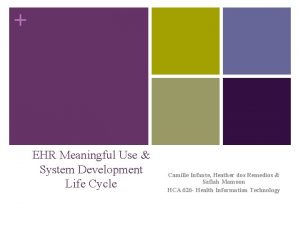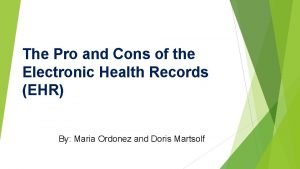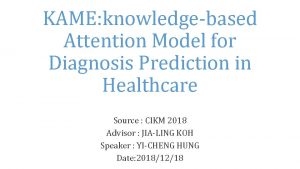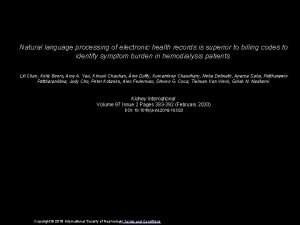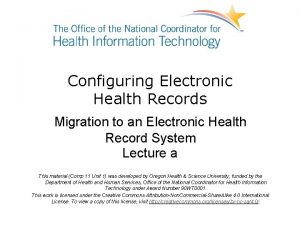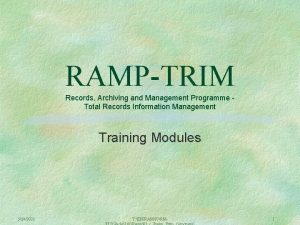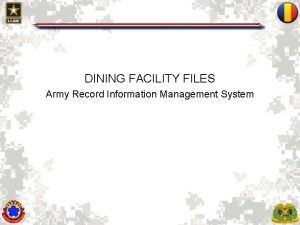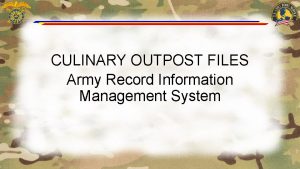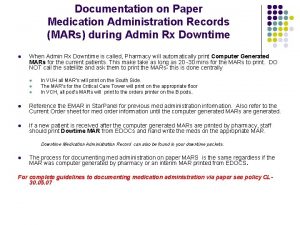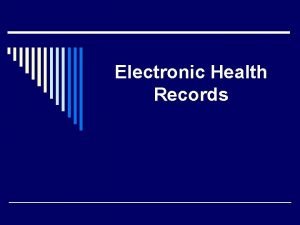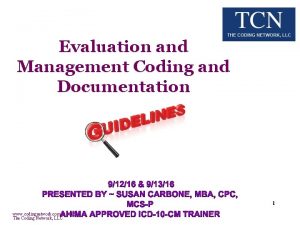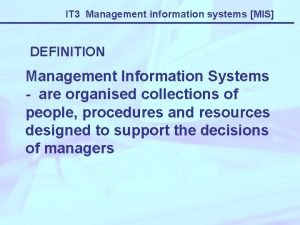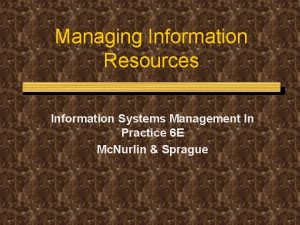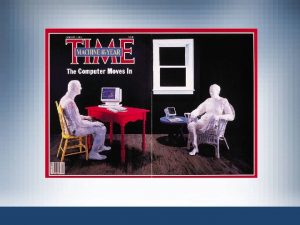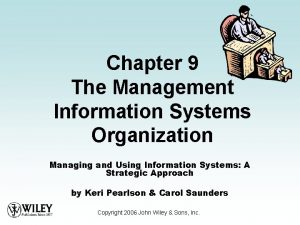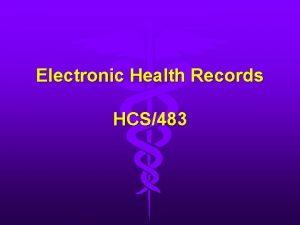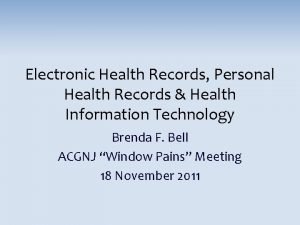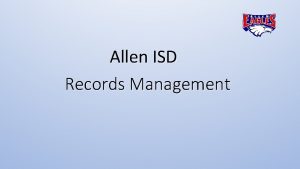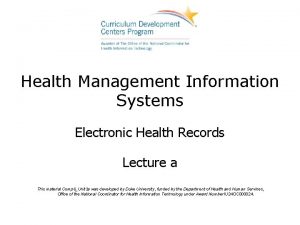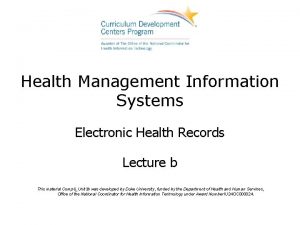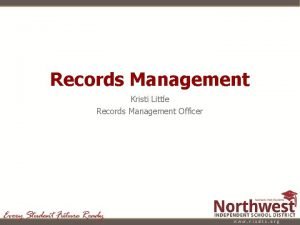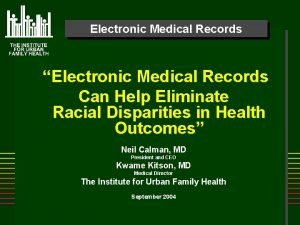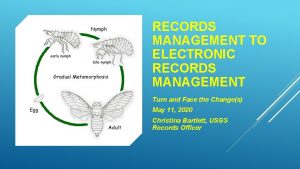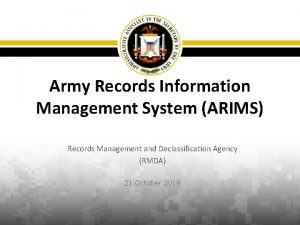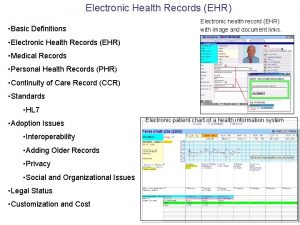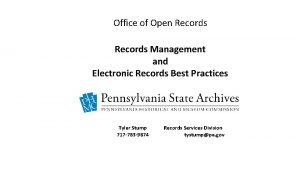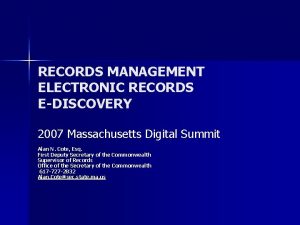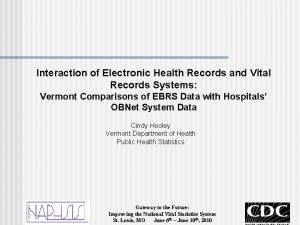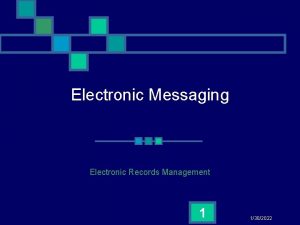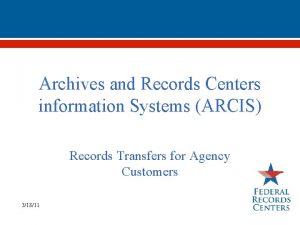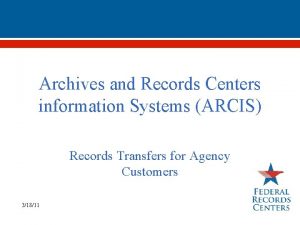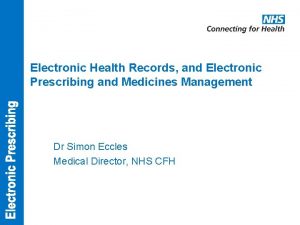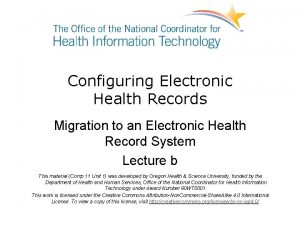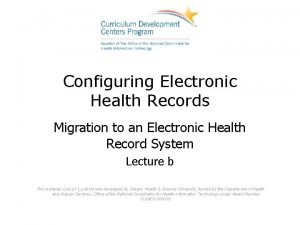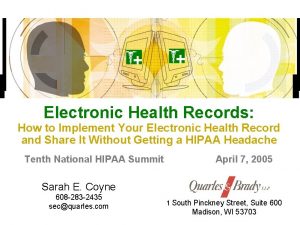Health Management Information Systems Electronic Health Records Lecture






























- Slides: 30

Health Management Information Systems Electronic Health Records Lecture a This material (Comp 6 Unit 3) was developed by Duke University, funded by the Department of Health and Human Services, Office of the National Coordinator for Health Information Technology under Award Number IU 24 OC 000024. This material was updated by Normandale Community College, funded under Award Number 90 WT 0003. This work is licensed under the Creative Commons Attribution-Non. Commercial-Share. Alike 4. 0 International License. To view a copy of this license, visit http: //creativecommons. org/licenses/by-nc-sa/4. 0/

Electronic Health Records Learning Objectives 1. State the similarities and differences between an electronic medical record (EMR) and electronic health record (EHR) 2. Identify attributes and functions of an EHR 3. Describe the perspectives of health care providers and the public regarding acceptance of or issues with an EHR, which can serve as facilitators of or major barriers to its adoption 4. Explain how the use of an EHR can affect patient care safety, efficiency of care practices, and patient outcomes 2

Electronic Medical Record (EMR) • Electronic record of health-related information on an individual – Within one health care organization 3

EMR Purpose • Provide an electronic equivalent of an individual’s legal medical record – Intra-organizational 4

Purpose of a Patient (Medical) Record • “To recall observations, to inform others, to instruct students, to gain knowledge, to monitor performance, and to justify interventions” • Serves as the legal business record 5

Electronic Health Record (EHR) • Electronic record of health-related information on an individual – Across more than one health care organization 6

EHR Purpose • Provide an electronic equivalent of an individual’s health record for use by providers and staff across more than one health care organization • Support efficient, high-quality integrated health care, independent of the place and time of health care delivery 7

EMR Versus EHR EMR A record of medical care created, managed, and maintained by one health care organization (intraorganizational) EHR A repository of individual health records that reside in numerous information systems and locations (inter-organizational) Integration of health care data from a Aggregation of health-related participating collection of systems from information into one record focused one health care organization around a person’s health history, i. e. , a comprehensive, longitudinal record Consulted by authorized clinicians and staff within one health care staff across more than one health care organization Data continuity throughout one health care organization Table 3. 1 EMR and EHR Comparison Data interoperability across different organizations 8

EHRs Versus Paper Records • EHRs can make a patient’s health information available when and where it is needed • EHRs can bring a patient’s total health information together in one place, and always be current • EHRs can support better follow-up information for patients • EHRs can improve patient and provider convenience 9

EHRs Versus Paper Records • EHRs – Can link information with patient computers to point to additional resources – Don’t just “contain” or transmit information, they also compute with it – Can improve safety 10

EHRs Versus Paper Records • EHRs can – Deliver more information in more directions o While reducing “paperwork” time for providers – Improve privacy and security – Reduce costs 11

Attributes of an EHR • Provides secure, reliable, real-time access to patient health record information, where and when it is needed to support care • Captures and manages episodic and longitudinal electronic health record information 12

Attributes continued • Functions as clinicians’ primary information resource during the provision of patient care • Assists with the work of planning and delivering evidence-based care to individual and groups of patients • Supports continuous quality improvement, utilization review, risk management, and performance monitoring 13

Attributes continued • Captures the patient health-related information needed for reimbursement • Provides longitudinal, appropriately masked information to support clinical research, public health reporting, and population health initiatives • Supports clinical trials 14

HL 7 EHR Functions • Direct care functions • Supportive functions • Information infrastructure functions 15

Direct Care Functions Subset Examples Manage clinical history Manage lists of clinical history Manage allergy list Manage medication history Manage orders Medication orders Manage lab test orders Manage blood product orders Dietary orders Manage sets of orders for specific diagnoses Manage care coordination and reporting Provide functionality to coordinate care with other providers Communicate the care provided to other providers Table 3. 2 HL 7 2014 EHR-S Functional Model Care Provisions Subsets with Examples 16

Administrative Support Functions • Manage Patient Demographics • Manage Communication • Manage Provider Information 17

Other EHR Functions • Care Provision Support Functions – Includes record management, functions that support result reporting, and support for patient education • Population Health Support Functions – Support for health maintenance and prevention, donor management, and public health related updates • Record Infrastructure Functions – This includes record lifecycle, record synchronization, and record archive and restore functions • Trust Infrastructure Functions – This important functional area includes security, audit and database backup and recovery features 18

Standards for Certification of EHR Technology • Content exchange standards – NCPDP SCRIPT Standard – HL 7 Clinical Document Architecture (CDA), CCD • Vocabulary standards – SNOMED CT – LOINC • Privacy and security standards – NIST encryption algorithm – NIST hashing algorithm 19

EHR Acceptance • Health care provider – Increasing momentum for widespread adoption and implementation of EHRs Changing reimbursement for patient care, focusing on managing patients across the continuum of care and between providers o Authorized Testing and Certification Body by the Office of the National Coordinator o 20

EHR Acceptance • Public – Ancker, et al (2013) surveyed the public on their perceptions of electronic health records o Improved quality § 66% thought EHRs would improve quality of care § Particularly true for patients whose doctor had an EHR in use o Concern over § Privacy, but not correlated with patients whose doctor used an EHR 21

EHR Acceptance: Public • Harris Interactive Survey – All physicians treating me should have access to information contained in my EMR o Percent answering "Strongly/Somewhat Agree" § 78% in 2009 § 78% in 2010 – An EMR would be a valuable tool to track the progress of my health o Percent answering "Strongly/Somewhat Agree" § 72% in 2009 § 71% in 2010 22

Barriers to Adoption • • Cost of conversion Perceived lack of ROI Technical and logistical challenges Privacy and security concerns 23

EHR Effect on Patient Care Safety • Reduces the need to repeat tests • Reduces the number of lost reports • Supports provider decision making 24

EHR Effect on Efficiency • Improves accessibility of patient information • Integrates data from multiple internal and external sources • Facilitates the coordination of health care delivery • Provides the ability to “hard wire” processes 25

EHR Effect on Patient Outcomes • Has the potential to o Improve the quality of patient care o Help providers practice better medicine o Provide seamless exchange of information among providers o Improve patient engagement in their own care 26

Electronic Health Records Summary – Lecture a • • Defined an EMR and EHR Explained similarities and differences Identified EHR attributes and functions Discussed the issues surrounding EHR adoption and implementation • Described the impact of EHRs on patient care 27

Electronic Health Records References – Lecture a References AHIMA e-HIM Work Group on Maintaining the Legal EHR. (2005). Update: Maintaining a legally sound health record—paper and electronic. Journal of AHIMA 76(10), 64 A-L. Retrieved from http: //library. ahima. org/xpedio/groups/public/documents/ahima/bok 1_028509. hcsp? d. Doc. Name=b ok 1_028509 Ancker, J. , Silver, M. , Miller, M. , & Kaushal, R. (2013, January 1). Consumer experience with and attitudes toward health information technology: A nationwide survey. Journal of American Medical Informatics Association, Jan 2013, 20 (1) 152 -156 Blumenthal, D. (2009, April 9). Stimulating the adoption of health information technology. New England Journal of Medicine 360, 1477 -1479. Retrieved from http: //www. nejm. org/doi/full/10. 1056/NEJMp 0901592 Handler, T. , Holtmeier, R. , Mtezger, J. , Overhage, M. , Taylor, S. , & Underwood, C. (2003, July 7). HIMSS electronic health record definitional model version 1. 0. Retrieved from http: //www. providersedge. com/ehdocs/ehr_articles/HIMSS_EMR_Definition_Model_v 1 -0. pdf Health Information Technology: Initial Set of Standards, Implementation Specifications, and Certification Criteria for Electronic Health Record Technology; Final Rule, 45 CFR Part 170 (July 28, 2010). Retrieved from http: //edocket. access. gpo. gov/2010/pdf/2010 -17210. pdf Harris Interactive. (2010, June 17). Few Americans using 'E-' medical records. Retrieve from http: //www. harrisinteractive. com/News. Room/Harris. Polls/tabid/447/ctl/Read. Custom%20 Default/mi d/1508/Article. Id/414/Default. aspx Health Level Seven International. (n. d. ). About HL 7. Retrieved from http: //www. hl 7. org/about/index. cfm? ref=nav 28

Electronic Health Records References – Lecture a References Health Level Seven International. (n. d. ). About HL 7. Retrieved from http: //www. hl 7. org/about/index. cfm? ref=nav Health Level Seven International. (2014). HL 7 2007 EHR-S functional model, Release 2. Retrieved from http: //www. hl 7. org/ehr/downloads/index. asp Radiological Society of North America. (2005, September). IHE moves EHR goals forward. Retrieved from http: //www. rsna. org/Publications/rsnanews/sep 05/ihe. cfm Reiser, S. J. (1991). The clinical record in medicine. Part 1: Learning from cases. Annals of Internal Medicine, 114, 902 -907. The National Alliance for Health Information Technology. (2008, April 28). Defining key health information technology terms. Retrieved from healthit. hhs. gov/portal/server. pt/gateway/PTARGS_0_10741_848133_0_0_18/10_2_hit_terms. pdf U. S. Department of Health and Human Services, Centers for Medicare and Medicaid Services. (2010, July 13). Electronic health records at a glance. Retrieved from https: //www. cms. gov/apps/media/press/factsheet. asp? Counter=3788&int. Num. Per. Page=10&check Date=&check. Key=&srch. Type=1&num. Days=3500&srch. Opt=0&srch. Data=&keyword. Type=All&chk. N ews. Type=6&int. Page=&show. All=&p. Year=&year=&desc=false&cbo. Order=date Charts, Tables, Figures 3. 1 Table: EMR and EHR Comparison 3. 2 Table: HL 7 2007 EHR-S Functional Model Direct Care Functions Subsets with Examples 29

Electronic Health Records Lecture a This material was developed by Duke University, funded by the Department of Health and Human Services, Office of the National Coordinator for Health Information Technology under Award Number IU 24 OC 000024. This material was updated by Normandale Community College, funded under Award Number 90 WT 0003. 30
 System development life cycle of electronic health records
System development life cycle of electronic health records Electronic medical records pros and cons
Electronic medical records pros and cons Electronic health records
Electronic health records Natural language generation for electronic health records
Natural language generation for electronic health records +electronic +health +records +migration
+electronic +health +records +migration Healthmis.ng
Healthmis.ng Recording business transactions
Recording business transactions Total records information management
Total records information management Army records information management system
Army records information management system Arims user guide
Arims user guide Electronic mars records
Electronic mars records Paper vs electronic medical records
Paper vs electronic medical records Uncitral model law on electronic signatures
Uncitral model law on electronic signatures Benefits of public health
Benefits of public health Electronic medical records
Electronic medical records 01:640:244 lecture notes - lecture 15: plat, idah, farad
01:640:244 lecture notes - lecture 15: plat, idah, farad Is the electronic exchange of money or scrip
Is the electronic exchange of money or scrip Electronic news gathering and electronic field production
Electronic news gathering and electronic field production Advanced operating system notes
Advanced operating system notes Articulators
Articulators Lecture sound systems
Lecture sound systems System chapter 1
System chapter 1 What is management information system
What is management information system Definition management information system
Definition management information system Information systems management in practice
Information systems management in practice Vertical
Vertical Information
Information Management information systems wiley
Management information systems wiley Essentials of mis, 13th edition
Essentials of mis, 13th edition Management information systems effy oz
Management information systems effy oz Introduction to management information systems 5th edition
Introduction to management information systems 5th edition
